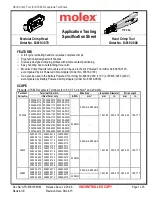
408-10040
Rev
G
10
of 12
1. Insert the insulation crimping adjustment pin in position 1 (Figure 9).
2. With the crimping dies bottomed, check the insulation barrel section of the crimping chamber (Figure 9)
as described in steps 4 and 5.
If the crimping chamber conforms to the gage inspection, the tool is considered dimensionally
correct. Lubricate it with a
thin
coat of any good SAE 20 motor oil.
If not, the tool must be returned to TE for further evaluation and repair. Refer to section 7,
REPLACEMENT AND REPAIR.
Figure 9: Inspecting the insulation barrel crimping dies
1
Gage
2
Adjustment pin in position 1
3
Wire barrel dies are bottomed, but not under pressure
4
GO gage must pass completely through the die closure
5
NO GO gage can enter partially, but must not pass completely through the die closure
For additional information regarding the use of plug gages, refer to instruction sheet
6.5.
Inspecting the ratchet control
The CERTI-CRIMP hand crimping tool ratchet control feature on TE hand tools must be checked to ensure that
the ratchet does not release prematurely, allowing the dies to open before they have fully bottomed.
1. Obtain a 0.025 mm [.001 in.] shim that is suitable for checking the clearance between the bottoming
surfaces of the crimping dies.
2. Select the maximum size wire for the tool and a terminal.
3. Position the terminal and wire between the crimping dies as described in section 3.
4. While holding the wire in place, squeeze the tool handles until the CERTI-CRIMP hand crimping tool
ratchet control releases. Hold the handles in this position, maintaining just enough tension to keep the
dies closed.
5. Check the clearance between the bottoming surfaces of the crimping dies with the 0.025 mm [.001 in.]
shim.
If the clearance is 0.025 mm [.001 in.] or less, the ratchet is considered satisfactory.
If the clearance exceeds 0.025 mm [.001 in.], the ratchet is out of adjustment and must be
repaired.






























